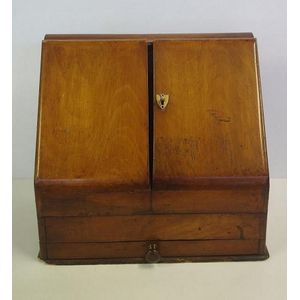George III Mahogany Swing Toilet Mirror with Gilded Border
George III mahogany swing toilet mirror the upright oblong mirror with gilded border and original silver plate, the serpentine platform base with three drawers on ogee bracket feet
You must be a subscriber, and be logged in to view price and dealer details.
Subscribe Now to view actual auction price for this item
When you subscribe, you have the option of setting the currency in which to display prices to $Au, $US, $NZ or Stg.
This item has been sold, and the description, image and price are for reference purposes only.
- Mahogany - Mahogany is a dense, close grained red-coloured timber from the West Indies and Central America. It was first imported into Europe in the the early 18th century and its use continued through the 19th century. It was popular for furniture making because of its strength, the wide boards available, the distinctive grain on some boards, termed flame mahogany and the rich warm colour of the timber when it was polished.. The "flame" was produced where a limb grew out from the trunk of the tree, and this timber was usually sliced into veneers for feature panels on doors, backs and cornices.
Some terms used to describe mahogany relate to the country from which it originally came, such as "Cuban" mahogany, "Honduras" mahogany etc. However unless the wood has been tested the names assigned are more a selling feature, rather than a true indication of the timber's origin. - George Iii - George III (1738 - 1820) was King of Great Britain and Ireland from 1760 to 1820.
- Gilding - Gilding is a method of ornamentation whereby a thin sheet of gold metal is applied to items made of wood, leather, ceramics, glass and silver for decorative purposes.
For furniture including mirrors, the sheet of gold is usually applied over a coating of gesso. Gesso is a mixture of plaster of Paris and gypsum mixed with water and then applied to the carved wooden frames of mirrors and picture frames as a base for applying the gold leaf. After numerous coats of gesso have been applied, allowed to dry and then sanded a coat of "bole", a usually red coloured mixture of clay and glue is brushed on and allowed to dry, after which the gold leaf is applied. Over time parts of the gilding will rub off so the base colour can be seen. In water gilding, this was generally a blue colour, while in oil gilding, the under layer was often yellow. In Victorian times, gilders frequently used red as a pigment beneath the gold leaf.
Metal was often gilded by a process known as fire gilding. Gold mixed with mercury was applied and heated, causing the mercury to evaporate, the long-term effect of which was to kill or disable the craftsman or woman from mercury poisoning. The pursuit of beauty has claimed many victims, not the least of which were the artists who made those pieces so highly sought after today. - Serpentine - Resembling a serpent, in the form of an elongated 'S'. A serpentine front is similar to a bow front, except that the curve is shallow at each end, swelling towards the middle. The term presumably derives from its similarity to a moving snake or serpent. Serpentine fronts are usually veneered, with the carcase either being cut and shaped from a solid piece of timber, or built in the 'brick' method.
- Platform Base - Flat-surfaced bases supporting the pedestals of dining tables and some other smaller occasional tables, including console and pier tables. Introduced during the Regency period, they continued in popularity throughout the 19th century. On tables, platform bases are usually of triform, or three-cornered shape, supported by bun, turned or carved claw feet. They may be either of veneered box-like construction, or formed from the solid timber.
- Ogee - A serpentine shape, usually convex at the upper part, concave at the lower. Mostly used to describe the front shapes of parts of carcass furniture, such as cornices, drawer fronts and feet.
- Bracket Feet - On bracket feet the corner edge is square and joined by a mitre to its partner on the opposite angle. The inner edge is usually shaped or scalloped. Bracket feet were first introduced in the early 18th century and used until c. 1830 and are found on carcase furniture such as chests, cabinets, bookcases and bureaux.
Ogee bracket feet, a variation on straight bracket feet, have the outside edge forming an "S" shaped curve with the top bulging outward and the bottom turning inward.
On splayed bracket feet, the exterior edge curves outward.
This item has been included into following indexes:
-
mirrors, toilet or dressing
- Georgian 70
- mahogany 228
- silver items 9
Visually similar items

A small late Georgian box-based toilet mirror, in flame mahogany with single drawer. Height 51 cm
Sold by
in
for
You can display prices in $Au, $US, $NZ or Stg.

Sold by
in
for
You can display prices in $Au, $US, $NZ or Stg.

Victorian mahogany stationary cabinet wedge shaped with hinged top, fitted interior with calendar, pen rest and letter racks enclosed by two panel doors, small drawer to base $300-500
Sold by
in
for
You can display prices in $Au, $US, $NZ or Stg.

Antique desk compendium with inside filing sleeves & calendar and a lower shallow drawer, 77.5 cm wide (when open)
Sold by
in
for
You can display prices in $Au, $US, $NZ or Stg.
